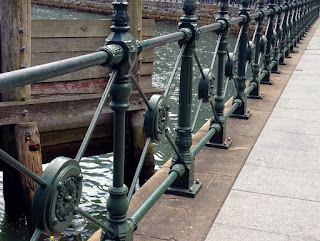 |
| The curve of the quay wall between Wharf 1 and Wharf 2 on the eastern side of the quay. |
| In the beginning ... the head of Sydney Cove was a tidal mudflat where the Tank Stream dribbled into the harbour. The cove, as Governor Philip noted in January 1788, was a deep harbour where ships of the realm could anchor in safety. Between 1837 and 1844 a military officer of the Royal Engineers, Captain George Barney, created a semi-circular quay, building a seawall and utilising thousands of convicts to reclaim about four and a half hectares of mudflats behind the wall; most of this fill came from the sandstone precipice dividing the two ends of Argyle Street, resulting in the Argyle Cut. The rest was cut from what is now the Tarpeian Walk adjacent to the Opera House forecourt. |
 |  |
| Left: A sketch by Jacob William Jones in 1845 (SL-NSW); Right: The balaustrade that sits atop the sandstone sea wall constructed by Barney and his iron-gangs. |
| It was not until 1854, however, that the quay was completed with the closure of the space where the Tank Stream entered the cove. It was after this closure, that the populace started to warm to the name "Circular Quay", even though the space is more a semi-oval. The Tank Stream now enters Sydney Cove in a storm-water drain just as you round Wharf 6 for the stroll along the front of the Museum of Contemporary Art (MCA). |
 |  |
| Left: A bustling Circular Quay in 1870 (National Archives of Australia number A1200, L85037
TLF resource R2583) Right: Barney's wall beside Wharf 2 |
4 comments:
The style of the fence appeals to me.
C'est un peu rude pour accoster. Il faut avoir de bonnes défenses (fenders).
It's amazing how simple engineering has changed our lives and our environment Julie.
Yes, Alain there are many buffers for ferries and other craft to come alongside. They do not have to bounce along the rough sandstone!
Post a Comment